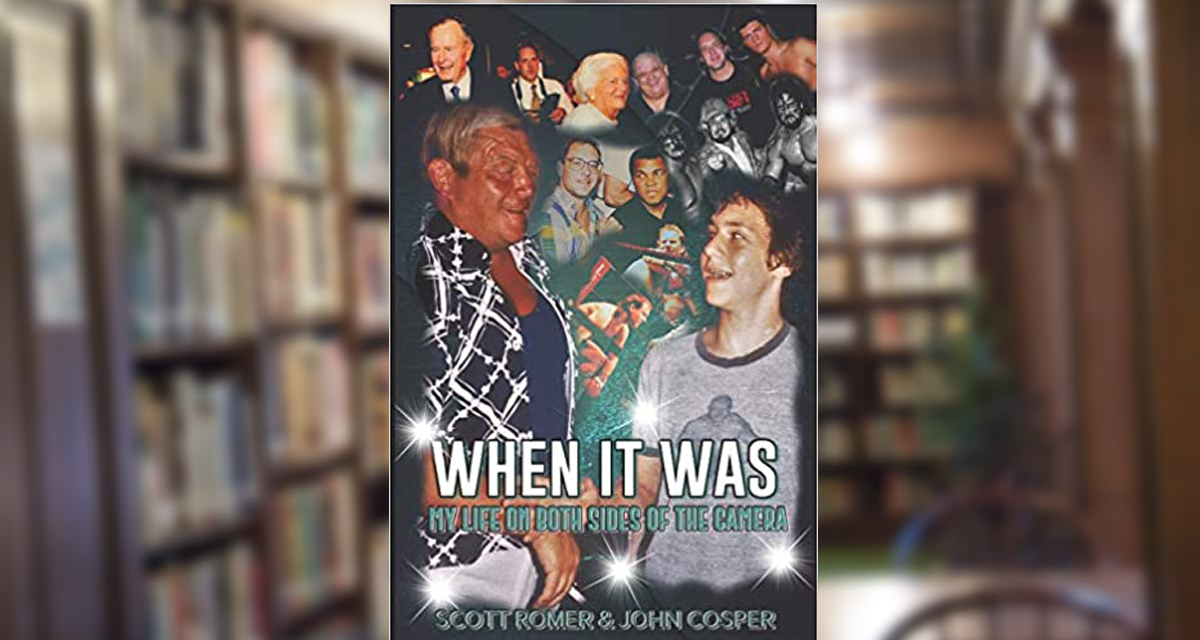There are people in this world who are open to every opportunity presented to them. The words “no” and “hesitation” don’t seem to exist in their vocabulary. They have mastered the craft of the hustle and it has served them well. Scott Romer is a prime example of this and he shares his fantastic life story in his new book When it Was: My Life on Both Sides of the Camera, out now from Eat Sleep Wrestle and written with John Cosper.

Scott Romer.
Wrote Cosper in the book’s preface: “For nearly 50 years, Scott Romer witnessed the world of boxing, wrestling and world events through the lens of his camera. Through the wonderful world of photography, Scott Romer has infiltrated the mob and the Yakuza, created peace between Jews and Arabs on a Palestinian soccer field, and was the only American and Jewish person allowed to cover the first and only World title bout in Nazareth, Israel.”
Added Romer in one of the book’s early chapters, “I’ve been very blessed to work what is essentially a side hustle as my full-time job almost my entire life. I started making money as a photographer when I was still a teenager. Since then I have worked as a wrestler, boxer, manager, corner guy, travel partner, and even a mule. I’ve seen the world and rubbed shoulders with world champions, presidents, and heads of state.”
Romer says he wanted to write a book because his mother, father and sister “didn’t believe anything that I did” and he was “written off as a goof to them.” Romer is candid in both the book and in a phone interview with SlamWrestling.net that he “spent his whole life trying to get the approval of my dad,” but sadly his father “wanted nothing to do with me.” Sadly, Romer’s father would pass away the day before our interview.
“I wanted to show them (my family) that what I had to say and what I have done in my life is extraordinary,” shared Romer, who resides in Carmel, Indiana. “And very few people have been able to accomplish what I have done as a photographer. And what I mean is working with some of the world leaders and Pulitzer prize winners, the pro wrestlers, the presidents and the prime ministers. Not everybody’s been fortunate enough to get their foot in the door to work that and I wanted to show my family that it was true!”

John Cosper.
The book is written as an oral history featuring quotes from Romer and his peers. The format is effective in providing a variety of perspectives to the book, but this reader would have liked the addition of the affiliation to Romer or job title after the names of everyone providing quotes. The book also has over 250 photos courtesy of Romer. Again, a slight criticism while I’m extremely jealous of all the people Romer has been photographed with especially the inclusion of the late Joan Rivers and the Macho Man Randy Savage, I felt the book relied too much on photos of Romer with famous people. I would have liked to see a better balance between the selfies and his body of work. This is the guy after all behind the Bruiser Brody photo that the popular VICE series, Dark Side of the Ring, used in their advertising! I wanted to feast my eyes on more of Romer’s impressive portfolio.
The title of the book, When it Was, is an homage to the same three words that Romer would use to start all the captions that would accompany the posts of his ample photos that he would share on his Facebook page. Romer pointed out that the format for the book was deliberate. “These people were with me and my experiences have been so unbelievable that some people would be doubtful unless I had pictures and quotes by these individuals (to prove it).”
The book smartly opens with Cosper accompanying Romer to a night of boxing at the Tyndall Armory in Indianapolis in December of 2019. (Yep, this is all pre-Covid folks! Remember live events?) Readers are immediately introduced to the urgency of Romer in action, taking photos and earning his bread by selling his wares. “He (Romer) races to his printing station, selects the best shots, and has them printed before the winner is finished with his requisite post-fight exam,” wrote Cosper.
Romer then shares that like so many of us he became immersed in the world of pro wrestling at an early age. “I became a fan the first time I ever saw it on TV,” remembered Romer. “And that would have been the early ’60s when I was just a toddler. I used to turn on the TV and turn the channel and I can remember the very first time there were adults yelling at each other. (It was) like what used to happen on the playground when I was in elementary school. My dad is bigger than you and he could beat you up! It rang such a bell in my mind that I fell in love with it. And to this day, I still love the business.” Romer’s grandfather, Thomas Gould, would further ignite Romer’s passion by taking him to live wrestling shows. One of the many psychiatrists that Romer saw during his childhood, to deal with his ADHD which he wasn’t diagnosed with officially until he was an adult, thought the shows would help Romer settle down and sit still.
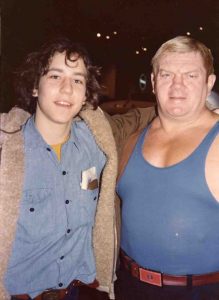
A young Romer with one of his “fathers,” Dick the Bruiser.
Romer’s passion for photography was the result of the group photos taken at several summer camps he attended. He says he was always fascinated by all the buttons on the cameras. Romer got his first camera as a prize by collecting and redeeming the wrappers of Bazooka Joe bubble gum. He would go on to replace that “cheap little camera” with a Kodak 104 Instamatic. Romer says he never took any formal classes on photography, he just always “had an eye for taking pictures.” He started taking photos at the local, live wrestling shows especially of his favorite wrestler, Dick the Bruiser. Romer would often attend the shows with childhood friend, David McLane, who would go on to create the original Gorgeous Ladies of Wrestling (GLOW) and the Women of Wrestling (WOW) promotion. Romer got the idea to start selling his photos at the wrestling shows, taking the extra steps of building his own dark room and developing his own film. Romer’s sales caught the attention of Bruiser, who in 1964 took control of the Indianapolis wrestling office with Wilbur Snyder. According to Romer, Bruiser called him to his office and said, “If you’re going to sell pictures at my show, we’re partners. You can sell them as long as I get some of the money.” Romer, just a high school student at the time, was now in business with Bruiser, handing over 20 per cent of his nightly sales.
Romer’s affiliation with Bruiser would go beyond photographs. Romer would marry Bruiser’s daughter (although the two are now divorced), they used to be next door neighbors and Romer actively participated in the family business: being in charge of transporting and setting up the ring for shows, becoming the heel wrestling manager, Saul Creatchman, and even wrestling! Romer admitted he didn’t exactly have time to properly train before entering the squared circle.
“They stuck me in the ring with really no clue on how to work properly,” explained Romer. “And so, there wasn’t any formal wrestling training. I knew how to do the expressions. And you know to work lighter (because) you can hurt somebody. I knew to do that! Because if I did anything that they could feel, they paid me back 10 times that much. So, I learned hands on. I wasn’t a true wrestler. I was more of a novelty.”
Despite the inexperience and proper skillset, Romer is proud of the fact that he has “been able to work in the ring with some of the most famous wrestlers alive.” He’s managed names including Harley Race, Mick Foley, the Honky Tonk Man, Jimmy Valiant and Rip Rogers. Romer also pointed out that he took part in the first intergender match in the state of Indiana when he faced promoter Bob Luce’s wife, Sharon Lass, in 1985.
Bruiser is one of Romer’s four mentors, that he affectionately refers to as his “fathers” and whom he credits throughout his book for being “instrumental in helping me become the person I am today.” In addition to Bruiser, there was wrestler, ring announcer and trainer Sam Menacker. Menacker and Romer first met when Romer, McLane and some other friends hilariously were able to put on a wrestling show, complete with fake blood, during a school assembly when they were still in elementary school. The group even managed to track down Bruiser’s phone number and invited him to their show. Bruiser declined, but sent Menacker to do the announcing instead. I doubt a stunt of this magnitude would fly at schools today! There was also George Randazzo, who founded the National Italian American Sports Hall of Fame and “opened a lot of doors for (Romer) to shoot some huge events and meet some amazing people.” Romer says Randazzo “was a well-connected guy” even to the mob. He made Romer his personal photographer in 1993. Finally, there was Indiana boxing promoter, Fred Berns. Not only would Romer take boxing photographs for Berns and even agree to step into the boxing ring himself, again with no formal training, but Berns would literally send Romer around the world to locales including Israel, Denmark, Germany, Italy and France to accompany his fighters.
Providing photographs for pro wrestling magazines would also result in some additional and infamous memories for Romer. In 1983, and with the help of reporter, pro wrestling personality and fellow photog Bill Apter, Romer began photographing the National Wrestling Alliance (NWA) shows in St. Louis. In 1984, the World Wrestling Federation (WWF, now World Wrestling Entertainment, WWE) began invading this and other pro wrestling territories by running their own shows and of course stealing talent away.
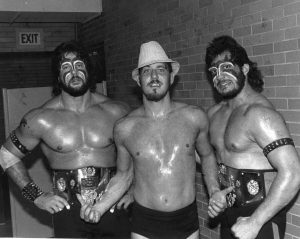
Romer, as Saul Creatchman, managed the tag team of Madd Max and Super Maxx better known as The World Warriors. The team defeated Dick the Bruiser and Jeff Van Camp for the World Wrestling Association (WWA) tag team titles in 1984.
“The WWF gave out a few press passes, but all the photographers had to shoot from up in the balcony except for me,” Romer wrote in the book. “I was able to get a ringside pass on the condition that the photos I took would only appear in the Japanese magazines. I was the only photographer not under contract to the WWF at ringside shooting side-by-side with the WWF’s official photographer, Steve Taylor. Steve’s photos appeared in the official WWF publications, and mine were published in Japan.”
As the North American representative for the Japanese magazine Gong, Romer even covered the funeral of David Von Erich. After the funeral, he also managed to find himself at the Von Erich homestead to interview patriarch Fritz and some of the other boys for the story. For this reader, summarizing this monumental event into a mere few sentences was definitely a missed opportunity in the book. For me, this event warranted further exploration and as a reader I wanted more details! Luckily, I was able to ask Romer about this experience when I interviewed him.
“As soon as I got to the church, and that was an hour and a half (before the funeral), so it was completely packed,” recalled Romer. “You couldn’t get in. And then on the outside, there were 5,000, 6,000 people with a loudspeaker. So, I did everything outside. And then I had talked to Fritz that I was going to be there, but he had never met me (in person). I can’t remember how I got his number. But as soon as they loaded David up into the hearse, I introduced myself to Fritz and gave him a hug. And at that time, the minister was standing around. And he was of course parked in the very front. So, he’s the first one to go in the procession. And for some reason or another, he said he’s going to the house and he saw that I was talking to Fritz, so all of a sudden, I was cool with him and he took me to Fritz Von Erich’s house!”
Romer further confessed, “I actually had a very pretty girl with me. And she was living in Dallas and she went with me (to the funeral). And she had actually asked him (Fritz) and we both did the interview. So, I think having a pretty girl by my side got attention and of course we didn’t take a lot of time with either one of the boys or Fritz. But we did get the interview and Bill Apter showed up as well and I think Bill Apter was very shocked to see I was not only with Fritz and the sons, but I was there before he ever showed up.” I’m sure for some readers Romer’s tactics may come off as opportunistic or even exploitative, but at the end of the day he got the story that so many pro wrestling publications wanted. Whether you approve or not, you have to admit, that took real chutzpah.
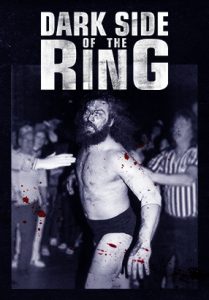
Romer’s photo of Bruiser Brody was used in the advertising for VICE’s Dark Side of the Ring series.
Thankfully, Romer dedicates an entire chapter to his part in one of the most controversial pro wrestling angles of all time: the “stabbing” of Atsushi Onita. In 1988, Bruiser Brody was stabbed by Jose Gonzales in the showers of a pro wrestling locker room in Puerto Rico, resulting in Brody’s death. Wrote Romer in the book, “Two years after the death of Bruiser Brody, Onita wanted to run an angle with Gonzales that would mirror the story of Bruiser’s death, and also give the Japanese fans, who dearly loved Brody, some closure.”
Romer was part of the Japanese press delegation that traveled to Puerto Rico to cover the contract signing between Onita and Gonzales.
“As with most wrestling contract signings, a fight broke out, and Gonzales and his henchmen jumped Onita,” wrote Romer in the book. “Onita gigged his forehead and started bleeding.”
But this is pro wrestling after all, so things didn’t end there. And according to Romer, what would follow was all unbeknownst to Gonzales.
“After Gonzales and his crew left the room,” Romer continued in the book. “Onita bladed himself in the stomach to make it appear as if he had been stabbed, just like Brody. He grimaced in pain as he cut himself, but he only got a small trickle of blood. I suggested he scoop some blood off the floor and wipe it on his shirt to get a better visual, so he did, making it look far worse than it was. I continued to snap photos as it all unfolded while all the other Japanese photographers stood back. One of the photographers pulled the fire alarm, and within minutes the police, fire department, and an ambulance arrived.”
Onita would be taken to the hospital by ambulance and Romer kept taking photos. According to Romer, Onita ended up with one stitch for his troubles, only after Onita insisted to the doctors it was necessary. Upon release from the hospital, Onita even went so far as to purchase some crutches and other first aid supplies to sell his “injuries.” Again, Romer continued to take photographs. Romer turned in his film and the next day at a wrestling show, in an eerily reminiscent situation, was called into the shower room of the babyface locker room by none other than Gonzales. Romer says Gonzales asked about him being previously married to Bruiser’s daughter and then asked Romer about Onita. Romer says Gonzales seemed genuinely confused when he mentioned Onita had been in the hospital after the contract signing. Romer quickly left the showers to go photograph the evening’s show.
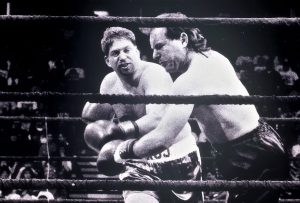
Yes Romer boxed too! Monte Cox takes down Romer. Romer was thrilled when boxing promoter, Fred Berns, used this photo in one of his newsletters.
“My photos of Onita were on the front pages of the evening papers in Japan,” recalled Romer in the book. “The story was all about how Jose Gonzales, whom every wrestling fan in Japan held responsible for the death of Bruiser Brody, had tried to murder Onita.”
Romer says he felt like he had been set up. “The death of Bruiser Brody was fresh in the minds of wrestling fans in Japan, who revered Brody,” he expressed in the book. “The Japanese press were running with the story, but they were hiding behind me and my photos to do it. That’s why I was the only person taking photos. They were using me for a patsy, letting me take the photos of a fake stabbing angle that could result in a very real assassination when Gonzales traveled to Japan (to take on Onita in their match)!”
The truth about the photos would come out via a Japanese television program before Gonzales was set to head to Japan for the match. Romer says he kept silent about the “stabbing” for 13 years, partly out of his respect for kayfabe (presenting pro wrestling storylines as real) and because he “didn’t realize the severity of that assignment” at the time. Romer would break his silence for Kayfabememories.com and Emerson Murray’s Bruiser Brody book. Romer says he also reached out to Gonzales to “let him know I had nothing to do with planning the angle.” But Romer did save one tidbit of the story for his own book: “Victor Quinones, who worked in the Puerto Rico office with Carlos Colon and Jose Gonzales, was there the whole time. He stayed behind after Gonzales left the room. He saw Onita blade his stomach. He never told Gonzales.”
Romer is thrilled to finally have his unconventional life on paper to share with readers. “Finally, after all these experiences that I have kept relatively silent on because some of them are too unbelievable to mention,” remarked Romer. “What am I going to write on my resume? Scott Romer, a photographer. What kind of assignments did you do? Well, I did stuff in Puerto Rico and a guy got stabbed! I’m unemployable! Fred (Berns) said that best (in the book). I’m unemployable, but I was happy! And I was so glad to have met John (Cosper) and for him to take the time to finally get what I’ve been going through down in a book.”
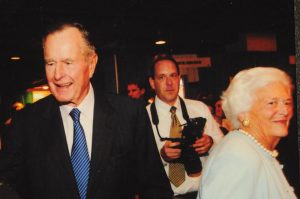
Romer had to get Secret Service clearance to photograph former President George H.W. Bush and First Lady Barbara Bush at the National Italian American Foundation ceremony in 2006.
Concluded Cosper, “Scott is a guy who is a phenomenal photographer. He’s an incredible storyteller. He is a hustler and, in that regard, he’s a guy who has made a living doing what he loves his entire life. And he’s also used what he does to get to meet some amazing people and experience amazing opportunities. It’s almost like Forrest Gump, some of the stories he has. And he’s certainly ADHD, but it’s something that served him well. He’s always on the move! It’s incredible to watch him at work and to see how he does what he does. To meet Scott Romer, you’ve got a friend for life. He’s a guy who’s very loyal and very good to everybody and doesn’t have a mean bone in his body.”
Overall, this reader enjoyed being taken on Romer’s journey. Romer’s fearlessness and enthusiasm for living an adventurous life is infectious. Yes, there were some stories I could have done without including the random and unfortunate sex toy prank involving Bruiser and his wife (shudder); Rip Rogers’ many references to the size of Romer’s penis (overkill and immature bravado) and a former girlfriend sharing she “might have lied about being 18” when she and Romer started dating along with unabashedly admitting to flashing “Fred Berns a few times.” There were also some photos in the book of Romer with certain people that I wanted to hear more about like Tonya Harding (Admit it! Who wasn’t enthralled in the Harding/Nancy Kerrigan Olympic figure skating scandal?) and actor Corey Feldman (again, not ashamed, The Lost Boys is an amazing movie and deserves the Criterion Collection treatment!). But upon reaching the end of the book, it’s undeniable that Romer has lived an incredible life and as a bonus, he’s got the photos to prove it!
RELATED LINKS
- Buy When it Was: My Life on Both Sides of the Camera from Eat Sleep Wrestle
- Buy When it Was: My Life on Both Sides of the Camera from Amazon.ca or Amazon.com
- Scott Romer: Facebook and Website
- John Cosper: Facebook and Twitter
- SlamWrestling Master Book List
